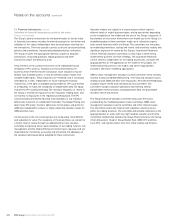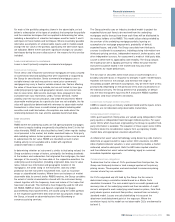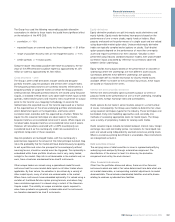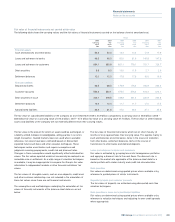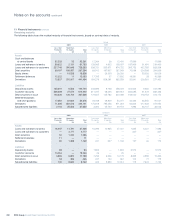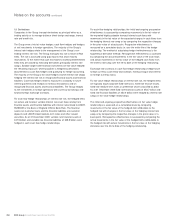RBS 2009 Annual Report Download - page 289
Download and view the complete annual report
Please find page 289 of the 2009 RBS annual report below. You can navigate through the pages in the report by either clicking on the pages listed below, or by using the keyword search tool below to find specific information within the annual report.
Financial statements
Notes on the accounts
287RBS Group Annual Report and Accounts 2009
The Group has used the following reasonably possible alternative
assumptions in relation to those inputs that could have significant effect
on the valuation of the APS CDS:
•correlation: +/- 10%
•expected losses on covered assets that have triggered: +/- £1 billion
•range of possible recovery rates on non-triggered assets: +/- 10%
•credit spreads: +/- 10 basis points
Using the above reasonably possible alternative assumptions, the fair
value of the APS derivative could be higher by approximately £1,370
million or lower by approximately £1,540 million.
Credit derivatives – other
The Group’s other credit derivatives include vanilla and bespoke
portfolio tranches, gap risk products and certain other unique trades.
The bespoke portfolio tranches are synthetic tranches referenced to a
bespoke portfolio of corporate names on which the Group purchases
credit protection. Bespoke portfolio tranches are valued using Gaussian
Copula, a standard method which uses observable market inputs (credit
spreads, index tranche prices and recovery rates) to generate an output
price for the tranche via a mapping methodology. In essence this
method takes the expected loss of the tranche expressed as a fraction
of the expected loss of the whole underlying portfolio and calculates
which detachment point on the liquid index, and hence which
correlation level, coincides with this expected loss fraction. Where the
inputs into this valuation technique are observable in the market,
bespoke tranches are considered to be level 2 assets. Where inputs are
not observable, bespoke tranches are considered to be level 3 assets.
However, all transactions executed with a CDPC counterparty are
considered level 3 as the counterparty credit risk assessment is a
significant component of these valuations.
Gap risk products are leveraged trades, with the counterparty’s
potential loss capped at the amount of the initial principal invested. Gap
risk is the probability that the market will move discontinuously too quickly
to exit a portfolio and return the principal to the counterparty without
incurring losses, should an unwind event be triggered. This optionality is
embedded within these portfolio structures and is very rarely traded
outright in the market. Gap risk is not observable in the markets and, as
such, these structures are deemed to be level 3 instruments.
Other unique trades are valued using a specialised model for each
instrument and the same market data inputs as all other trades where
applicable. By their nature, the valuation is also driven by a variety of
other model inputs, many of which are unobservable in the market.
Where these instruments have embedded optionality it is valued using a
variation of the Black-Scholes option pricing formula, and where they
have correlation exposure it is valued using a variant of the Gaussian
Copula model. The volatility or unique correlation inputs required to
value these products are generally unobservable and the instruments
are therefore deemed to be level 3 instruments.
Equity derivatives
Equity derivative products are split into equity exotic derivatives and
equity hybrids. Equity exotic derivatives have payouts based on the
performance of one or more stocks, equity funds or indices. Most
payouts are based on the performance of a single asset and are valued
using observable market option data. Unobservable equity derivative
trades are typically complex basket options on stocks. Such basket
option payouts depend on the performance of more than one equity
asset and require correlations for their valuation. Valuation is then
performed using industry standard valuation models, with unobservable
correlation inputs calculated by reference to correlations observed
between similar underlyings.
Equity hybrids have payouts based on the performance of a basket of
underlyings where the underlyings are from different asset classes.
Correlations between these different underlyings are typically
unobservable with no market information for closely related assets
available. Where no market for the correlation input exists, these inputs
are based on historical time series.
Interest rate and commodity derivatives
Interest rate and commodity options provide a payout (or series of
payouts) linked to the performance of one or more underlying, including
interest rates, foreign exchange rates and commodities.
Exotic options do not trade in active markets except in a small number
of cases. Consequently, the Group uses models to determine fair value
using valuation techniques typical for the industry. These techniques can
be divided, firstly, into modelling approaches and, secondly, into
methods of assessing appropriate levels for model inputs. The Group
uses a variety of proprietary models for valuing exotic trades.
Exotic valuation inputs include correlation between interest rates, foreign
exchange rates and commodity prices. Correlations for more liquid rate
pairs are valued using independently sourced consensus pricing levels.
Where a consensus pricing benchmark is unavailable, these instruments
are categorised as level 3.
Debt securities in issue
The carrying value of debt securities in issue is represented partly by
underlying cash and partly through a derivative component. The
classification of the amount in level 3 is driven by the derivative
component and not by the cash element.
Other financial instruments
Other than the portfolios discussed above, there are other financial
instruments which are held at fair value determined from data which are
not market observable, or incorporating material adjustments to market
observed data. These include subordinated liabilities and write downs
relating to undrawn syndicated loan facilities.



